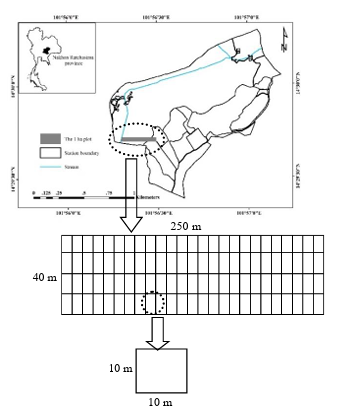Forest Structure and Species composition in the Dry Evergreen Forest at Wang Nam Khiao Forestry Student Training and Research Station, Nakhon Ratchasima Province
Keywords:
Disturbance, Dry Evergreen Forest, Forestry Training Station, Plant DiversityAbstract
In Thailand, the dry evergreen forest, DEF, is known as high biological diversity, however, it classified as under threaten status due to land use changes. This study aimed to classify the forest structure and species composition of the DEF after disturbed at Wang Nam Khiao Forestry Student Training and Research Station. In 2002, a permanent plot, 40 m x 250 m was established. All trees with diameter at breast height, DBH, ? 2 cm were tagged, measured, identified, and recorded tree position in the plot. The monitoring was done every 2-year during the first period (2002-2006) and 2018. The forest structure and species composition in 2018 showed that total 96 species 72 genera and 34 families for tree DBH ? 2cm were found. The forest characterized by high species density with low basal area, 3,385 individusl.ha-1 and 20.01 m2.ha-1, respectively. In addition, intermediate diversity was found (H/ = 2.67), indicating this forest had influenced on disturbance, particular illegal cutting. The dominance family based on number of species was Rubiaceae, Ebenaceae, Fabaceae, Meliaceae, and Annonaceae which had 9, 7, 7, 7, 7, and 6 species, respectively. While, the family of Meliaceae had the highest tree density and followed by Fabaceae, Moraceae, Phyllanthaceae and Achariaceae, respectively. The distribution of tree based on diameter class of this forest had negative exponential growth form or L-shape. Indicating the good natural regeneration was detected which small trees can be replaced the mature trees in the futher. However, the pioneer species such as Microcos tomentosa, Streblus ilicifolius, Leucaena leucocephala, and Sterculia pexa, had well established under the gap or open areas, indicating the intermediate disturbed may help to maintain its diversity.
Downloads



.png)





